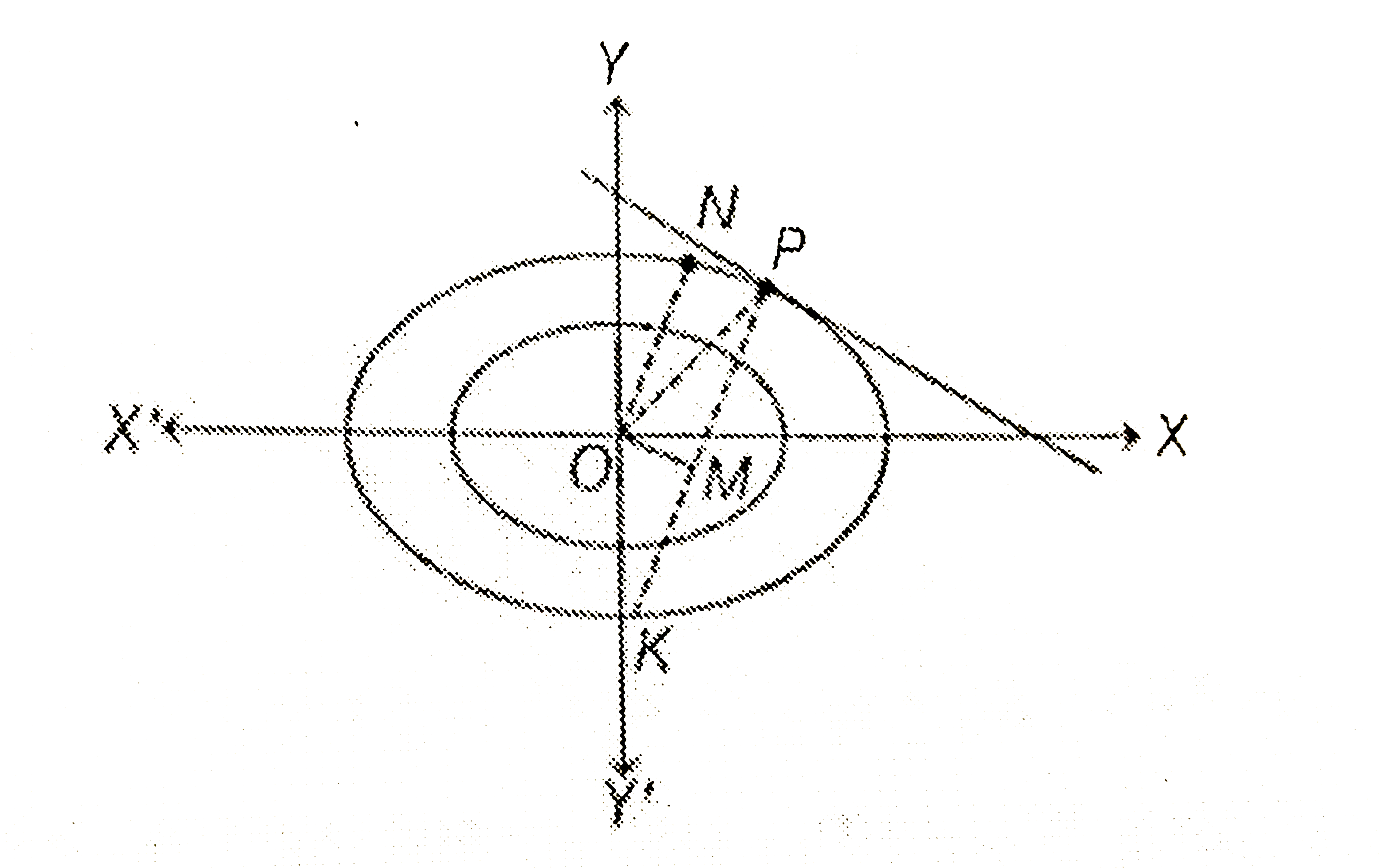Find the co-ordinates of all the points P on the ellipse, x2a2+y2b2=1 ,for which the area of the triangle PON is maximum, where O denotes the origin and N, the foot of the perpendicular from O to tangent at P.
(±a2√a2+b2,±b2√a2+b2)
(±a2√a2−b2,±b2√a2−b2)
(±a2√a2+b2,±b2√a2−b2)
(±a2√a2−b2,±b2√a2+b2)
The correct Answer is:A
Let the coordinates of P be (acosθ,bsinθ)
Equations of tangent at P is

xacosθ+ybsinθ=1
Again, equation of normal at point P is
axsecθ−bycosecθ=a2−b2
Let M be font of perpendicular from O to PK, the normal at P.
Area of ΔOPN=12 ( Area of rectangle OMPN)
=12ON⋅OM
Now, ON=1√cos2θa2+sin2θb2=ab√b2cos2θ+a2sin2θ
[ perpendicular from O, to line NP]
and OM =a2−b2√a2sec2θ+b2cosec2θ=(a2−b2)⋅cosθ⋅sinθ2(a2sin2θ+b2cos2θ)
=ab(a2−b2)tanθa(a2tan2θ+b2)
Let f(θ)=tanθα2tan2θ+b2 [0<θπ/2]
f'(θ)=sec2θ(a2tan2θ+b2)□−tanθ(2a2tanθsec2θ)(a2tan2θ+b2)
=sec2θ(a2tan2θ+b2−2a2tan2θ)(a2tan2θ+b2)2
=sec2θ(atanθ+b)(b−atanθ)(a2tan2θ+b2)2
For maximum or minimum, we put
f'(θ)=0⇒b−αtanθ=0
[sec2θ≠0,atanθ+b≠0,0<θ<π/2]
⇒ tanθ=b/a
Also, f'(θ){>0,if0<θ<tan−1(b/a)<0,iftan−1(b/a)<θ<π/2
Therefore, f(θ) has maximum, when
θ=tan−1(ba)⇒tanθ=ba
Again, sinθ=b√a2+b2,cosθ=a√a2+b2
By using symmetry, we get the required points.
(±a2√a2+b2,±b2√a2+b2)
Topper's Solved these Questions
- APPLICATION OF DERIVATIVES BOOK - IIT JEE PREVIOUS YEARCHAPTER - APPLICATION OF DERIVATIVES EXERCISE - MAXIMA AND MINIMA (OBJECTIVE QUESTIONS II)
8 Videos
- APPLICATION OF DERIVATIVES BOOK - IIT JEE PREVIOUS YEARCHAPTER - APPLICATION OF DERIVATIVES EXERCISE - MAXIMA AND MINIMA (MATCH THE COLUMNS)
1 Video
- APPLICATION OF DERIVATIVES BOOK - IIT JEE PREVIOUS YEARCHAPTER - APPLICATION OF DERIVATIVES EXERCISE - ROLLES AND LAGRANGES THEOREM (ANALYTICAL & DESCRIPTIVE QUESTION)
1 Video
- 3D GeometryBOOK - IIT JEE PREVIOUS YEARCHAPTER - 3D GeometryEXERCISE - Equation of Plane Objective Question II (Integer Answer Type Question)
1 Video
- AREABOOK - IIT JEE PREVIOUS YEARCHAPTER - AREAEXERCISE - AREA USING INTEGRATION
55 Videos
Similar Questions
Knowledge Check
From centre O, of the ellipse x216+y29=1, two perpendicular rays are drawn meeting the ellipse at P and Q, N is the foot of perpendicular from O to PQ, then:
A1OP2+1OQ2=25144B1OP2−1OQ2=25144CON=125DON=65Let P be a variable point on the elipse x2a2+y2b2=1 with foci F1andF2. If A is the area of the triangle PF1F2, then maximum value of A is
AabeBabe(c)C2abeDnoneIf the co-ordinates of the points P and Q are (1,−2,1)and(2,3,4) and O is the origin, then
AOP=OQBOP⊥OQCOP∣∣OQDOP and OQ intersect at an angle of 45∘
the co-ordinates of the point P(x,y) lying in the first quadrant on the ellipse x28+y218=1 so that area of the triangle formed by the tangent at P and the co-ordinate axes is the smallest, are given by
View SolutionIf the normal to the ellipse x225+y21=1 is at a distance p from the origin then the maximum value of p is
View SolutionFind the co-ordinates of the foot of perpendicular drawn from the point (3,−3) to the line x−2y=4.
View SolutionP is a variable point on the ellipse "9x2+16y2=144" with foci S and S′.Then maximum area of the triangle "SS'P" is
View SolutionQ is a point on the auxiliary circle corresponding to the point P of the ellipse x2a2+y2b2=1 If T is the foot of the perpendicular dropped from the focus S onto the tangent to the auxiliary circle at Q then the ΔSPT is
View Solution
